Male Pattern Baldness is the primary cause of 95% of all hair loss in men.
Let that sink in.
The fact that all the numerous causes for hair loss other than male pattern baldness cause a tiny part of hair loss in the world is troubling.
To make it more intimidating, I should point out that around half of every man in the world will have significantly visible balding by age 50.
But it’s not all bad news. There are ways to slow down, stop, and even revert pattern hair loss for men.
In this article, I’ll explain everything you need to know about male pattern baldness, what it is, how it is diagnosed, what causes it, and your best options for stopping it.
TL;DR
➡ MPB is a hereditary and most common type of hair loss caused in the world. As its progress gains a clear M shape on your scalp, we start diagnosing its level based on the Norwood scale.
➡ MPB is caused by a hormone called dihydrotestosterone (DHT) that slows your body’s healing process for new hair follicles. This can progress into permanent baldness on your head as time goes by.
➡ Depending on how much your balding has progressed, several methods for stopping further hair loss and regrowing hairs are possible such as Finasteride, Minoxidil, changes in lifestyle, and hair transplants.
➡ How YOUR hair loss will evolve in the coming years? You’ll find the answer to this question in this article.
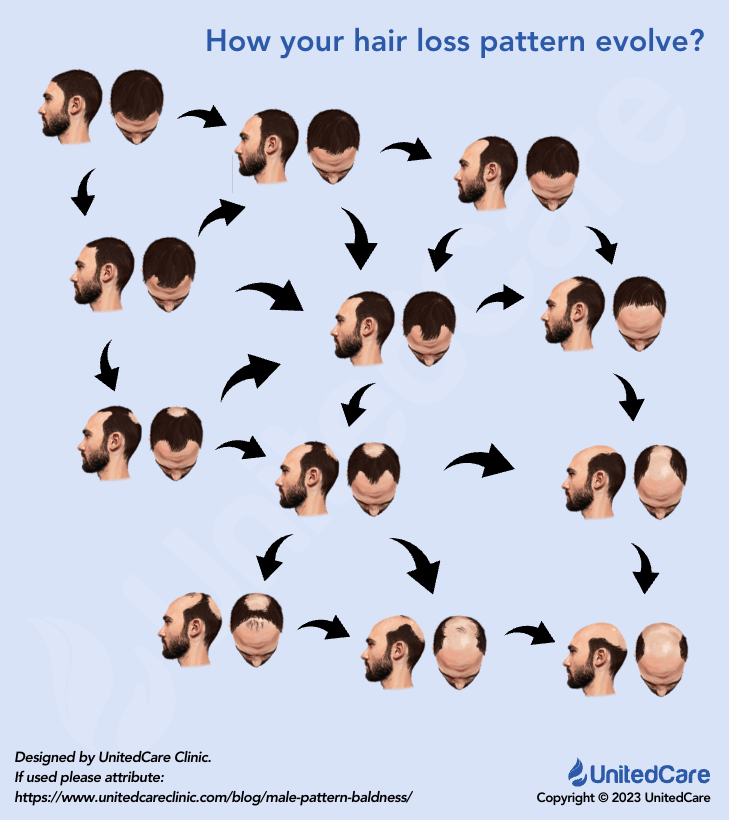
Table of Contents
Of course, understanding the condition is the first step of every effective treatment.
What is Male Pattern Baldness?
Male Pattern Baldness, also referred to as Androgenetic Alopecia or AGA, is a hereditary and common type of hair loss that accounts for most of the world’s balding. It progresses in a pattern of M on top of your crown area on the frontal part of your scalp.
Male pattern baldness progresses slowly over the years towards permanent partial or complete baldness on your head, if not intervened.
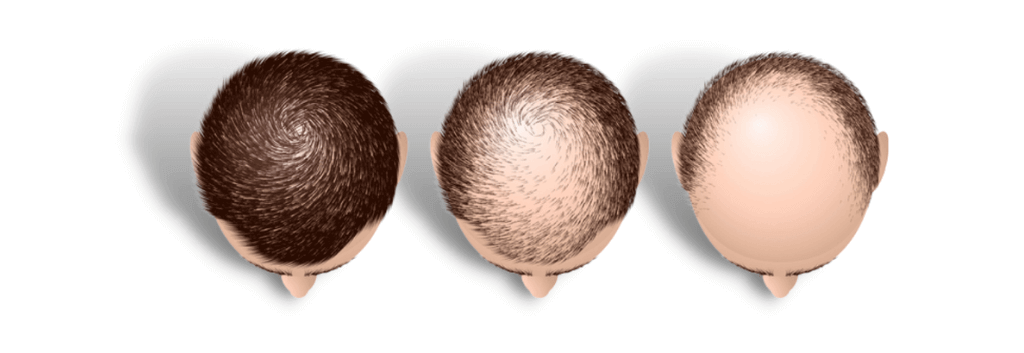
Women can also suffer from female pattern baldness, but their chances of hair loss due to pattern baldness are significantly lower than men’s, and the pattern of female pattern hair loss is different than male pattern baldness while also being milder.
Male pattern balding is strongly associated with the influence of male hormones called androgens, specifically dihydrotestosterone (DHT), after puberty. Most patients become certain of their pattern of hair loss in their mid-20s, which I’ll explain the reason for in the later sections.
This hair loss form is not unavertable nor reversible, but early diagnosis is key to treating it:
3 Key Signs of Male Pattern Baldness
Since you’re reading this article, you already have seen a sign of balding or are concerned about losing your hair for your own reason.
Being concerned about this topic is great. That means you’re actively looking for a way to prevent/reverse it.
The first step you need to take in this journey is making sure of your possible balding, which these 3 key signs will help you with:
1- Having Many Relatives with Pattern Balding
This sign can be obvious very early in your journey, especially if both sides of your family have a strong history of hair loss in men.
Male pattern baldness is evaluated as a hereditary disease since your genes have a crucial role in determining how you respond to certain hormones, especially DHT.
Make a list of all your close male relatives and evaluate the progress of their balding at their current age, draw out common patterns, and even ask them what age they first noticed their balding.
If most of your family members still possess a full head of hair in adulthood, you can consider yourself lucky.
But, if most of your male relatives have severe baldness, it might be time to visit your dermatologist. The odds of you not developing pattern baldness despite a balding history in your family is extremely low.
If that’s the situation, you can visit your dermatologist as soon as possible for a routine check-up and an evaluation of your hair and scalp. In pattern baldness, the earlier a patient is diagnosed, the more options for treating the condition they will have.
2- Shedding an Unusual Number of Hairs Daily
This sign goes unnoticed by many hair loss patients.
50-100 of your individual hairs falling out every day is completely natural, as your hair follicles grow new ones in the places of these through the hair growth cycle.
But, if you’re exceeding the natural amount and the number of hairs you shed increases over time, you might’ve come across a sign.
You might see more and more hairs on your pillowcase when you wake up, in the drainage when you shower, on your comb when you fix or comb your hair, and even on your hand when you slide it through your scalp.
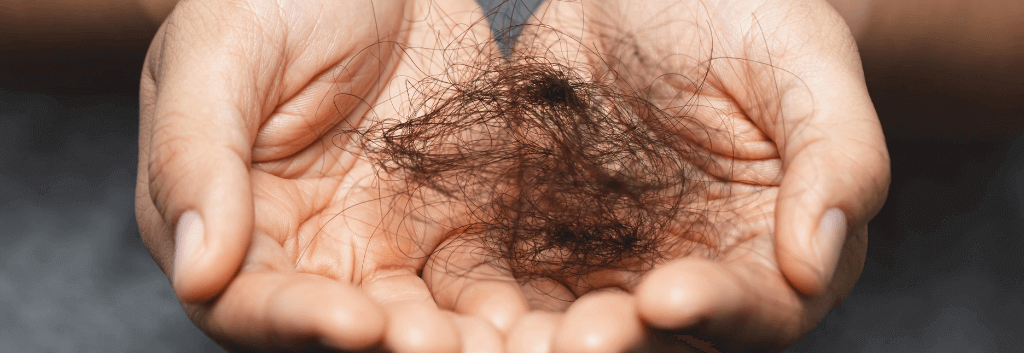
If you have any doubts, you can schedule an appointment with your dermatologist. If you haven’t seen the third sign yet and just realized it, it’s still very early for you to treat and manage your hair loss.
3- Receding Hair Line and Visible Balding
Most of my patients come for an examination after seeing this sign.
They see their hairline change and balding patterns, especially when they compare their current appearance to their past using photographs or their close friends and family tell them they’re starting to bald. Either way, this sign becomes noticeable once your pattern balding has progressed.
You need to lose tens of thousands of hairs to observe balding and hairline receding on your scalp during your day-to-day activities. And if you’re sure you’ve got this sign, your pattern baldness progressed a lot.
But unless you ignore this sign for a long time and don’t do anything to fix the situation until you have severe baldness, you’re still not late.
Some patients may even see this sign and reverse the adverse effects of pattern baldness without any surgical procedure.
The next step when you’ve made sure you’ve seen the signs is identifying what part of the journey you currently are on:
Baldness Patterns of Androgenic Alopecia
Hair loss is not exactly the same in every male patient, but the hair loss patterns are similar for everyone.
In 1950, James Hamilton noticed this and introduced a scale for measuring the progress of hair loss.
And in the 1970s, O’Tar Norwood updated this scaling to make it convenient for dermatologists and hair loss patients worldwide.
This scale commonly referred to as the Hamilton-Norwood classification system, helps you see how your pattern baldness is progressing and what you should look for.
Here’s how it looks like:
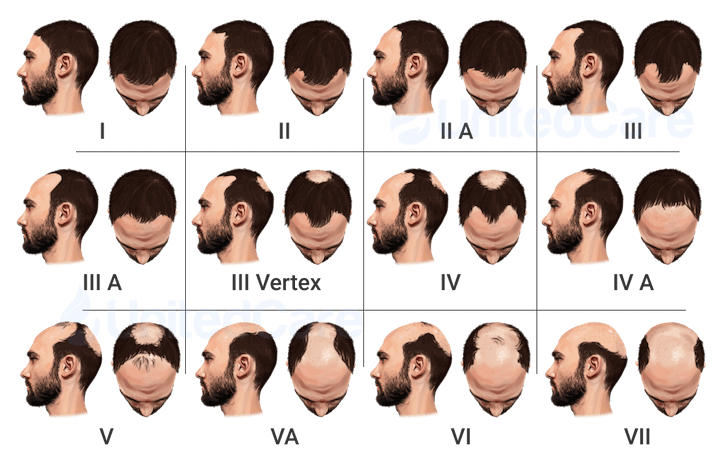
If you’re certain you’re experiencing male pattern baldness, you must belong to a part of this scale.
Let’s quickly go over the scale from the start and see the patterns male pattern baldness progresses:
Typical Baldness Pattern
Hair loss in most MPB patients follow the typical pattern in the Hamilton-Norwood scale.
Type 1
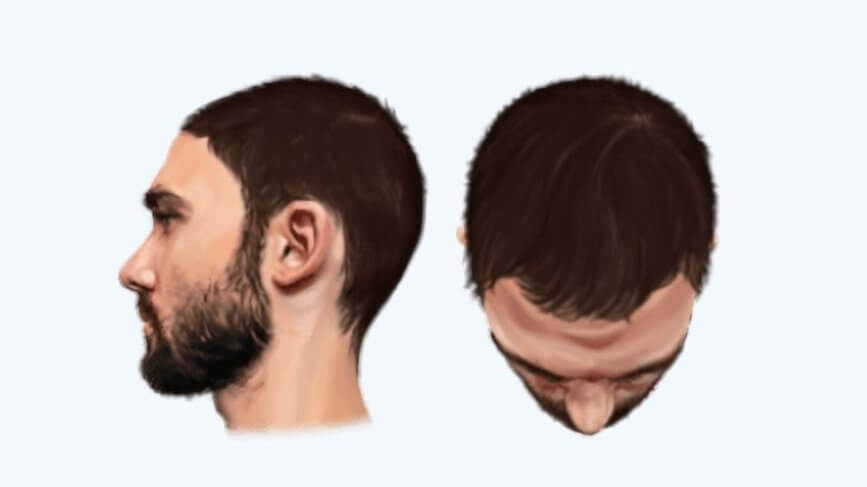
Type 1 means you have a full head of hair. It is what the scalp of a male without any hair loss looks like.
Type 2
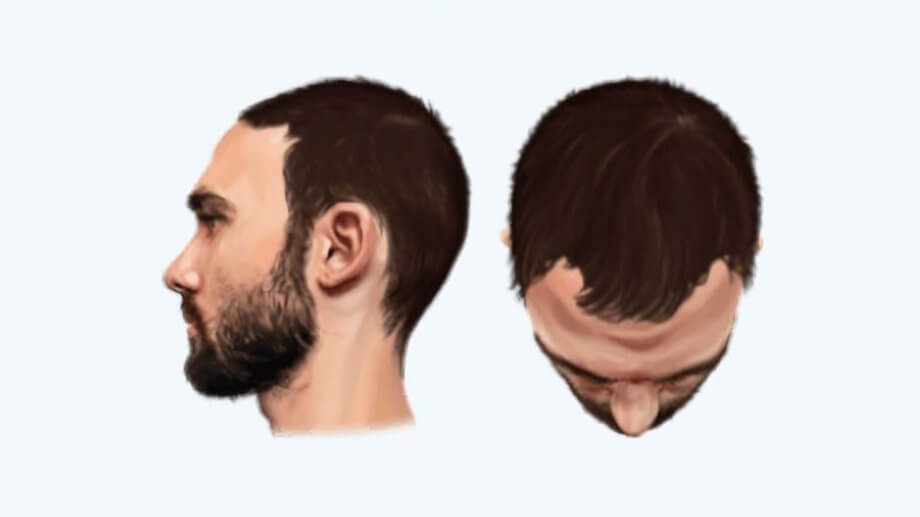
Your hairline recedes mainly in the sides of your frontal scalp. It can also be seen in aged men who don’t suffer from MPB.
Type 3
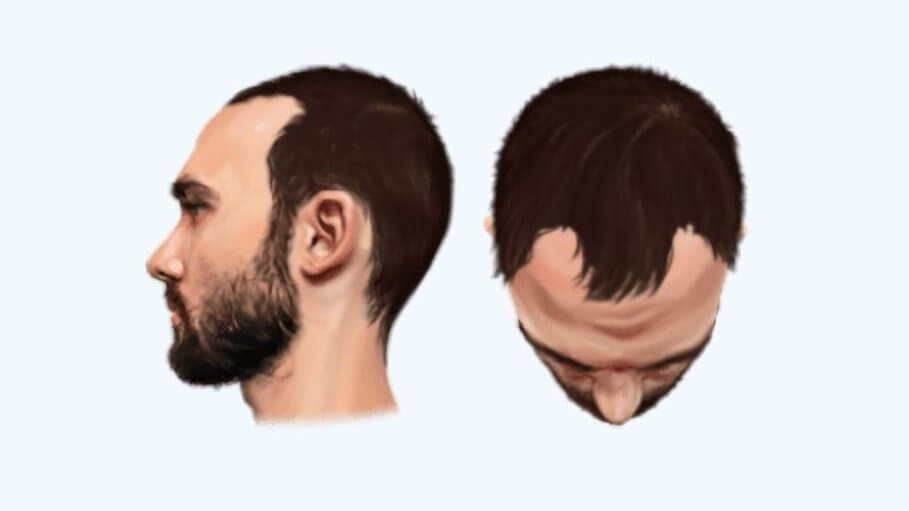
Hair loss on the frontal part of your scalp progresses deeper into your mid-scalp. Based on your age and the rate of hair loss, you can be diagnosed with MPB.
If diagnosed, you can start finasteride treatment to prevent further hair loss. You can also restore your hairline with an (on average) 2500 graft hair transplant.
Type 4
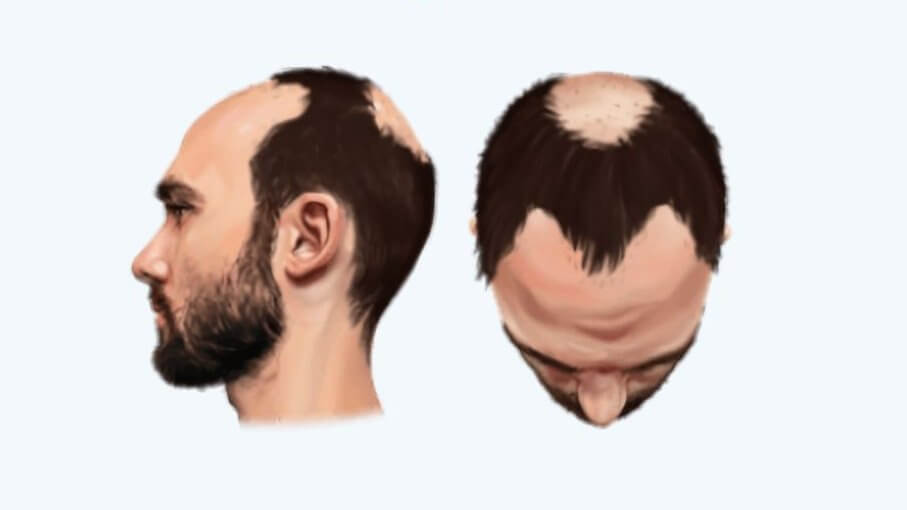
Your hairline recedes further into your scalp, and bald spots in your vertex become visible. Also, hair loss around your temples progresses, and the hairline around these parts is disrupted significantly.
In most cases, a 3500 graft hair transplant can help you restore your hairline.
Type 5
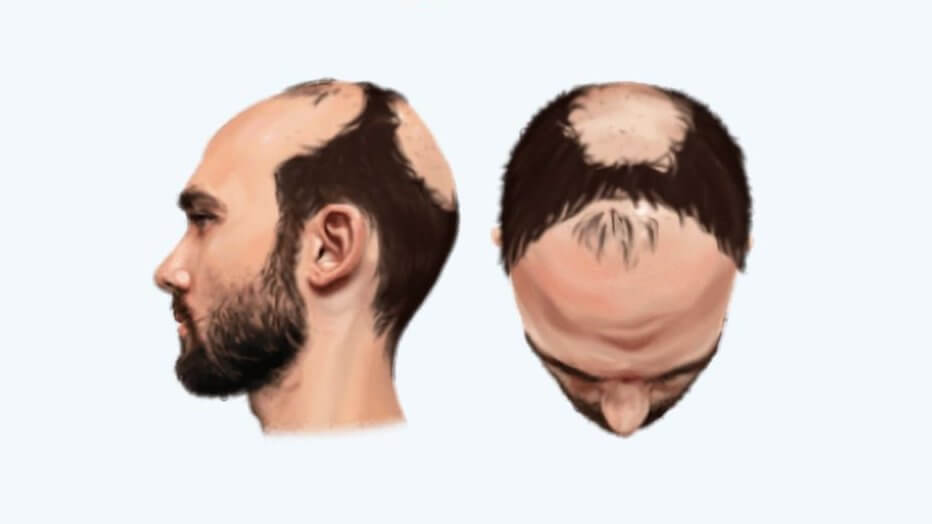
At this stage, there’s barely any hair left on the frontal part of your scalp, and the bald spot around the vertex grows further.
Type 6
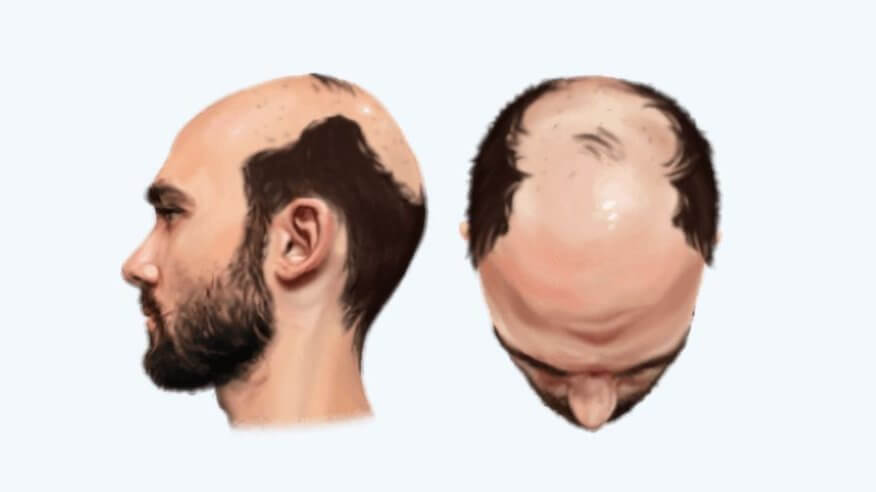
At this stage, hair loss progresses, and the bald spots on the frontal scalp and vertex are now connected.
Type 7
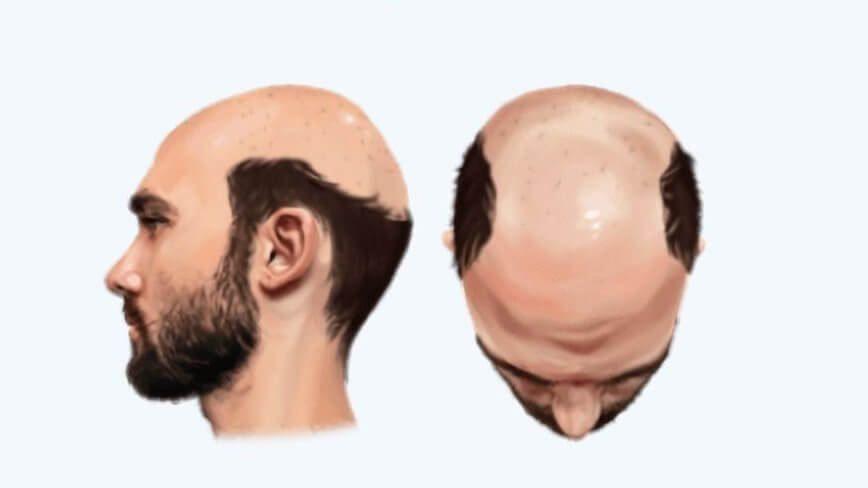
MPB progresses, and there’s usually no hair left on the top of your scalp. The only hair left is on the sides and back, immune to DHT’s effects, which causes pattern baldness.
Type A Baldness Pattern
O’Tar Norwood, who perfected the scale, added the A variant to the scale, alongside the typical pattern.
The biggest difference this pattern has is that the hair loss in the vertex doesn’t happen until the hair loss on the frontal lobe of the scalp reaches this part.
Also, the hairline on the frontal part of the scalp progresses equally on the sides and the middle, compared to the middle resisting shedding until Type 5 in the typical pattern.
Type 2A
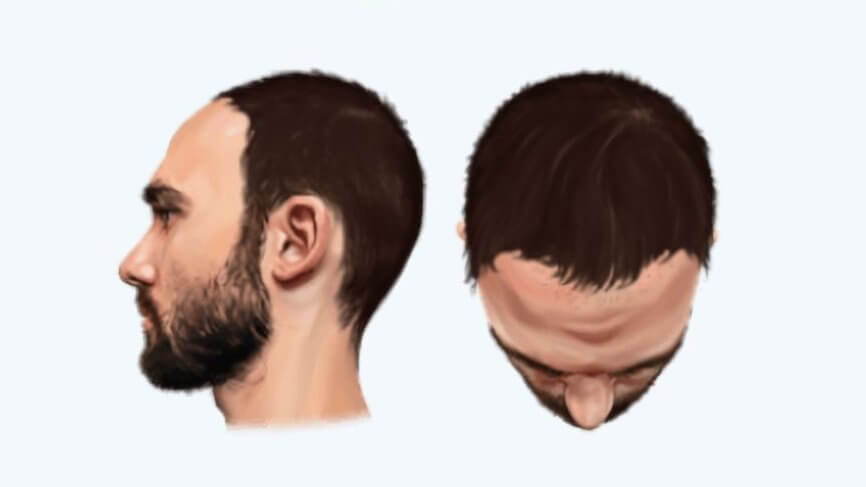
In Type 2A, your frontal hairline recedes equally.
Type 3A
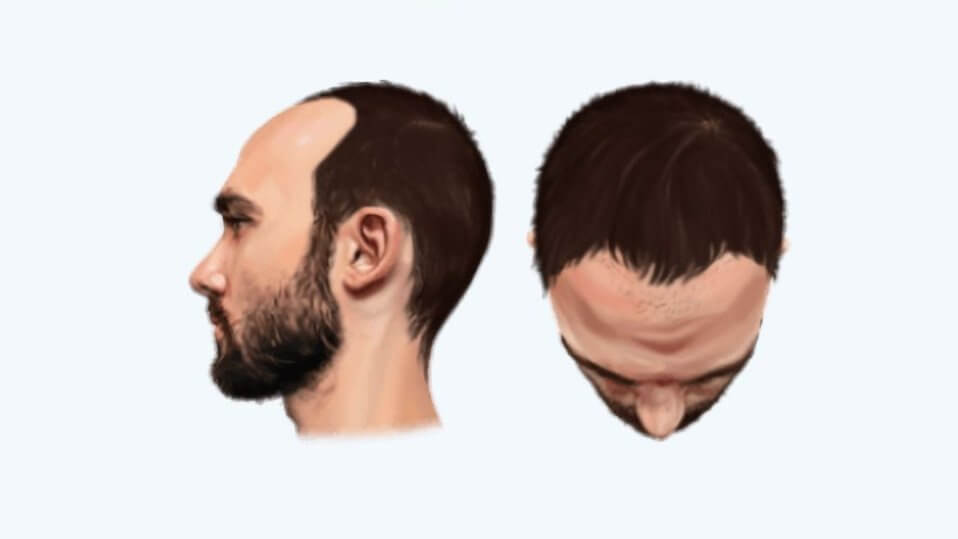
At this stage, balding progresses even further, and hair loss in the temples become visible.
Type 4A
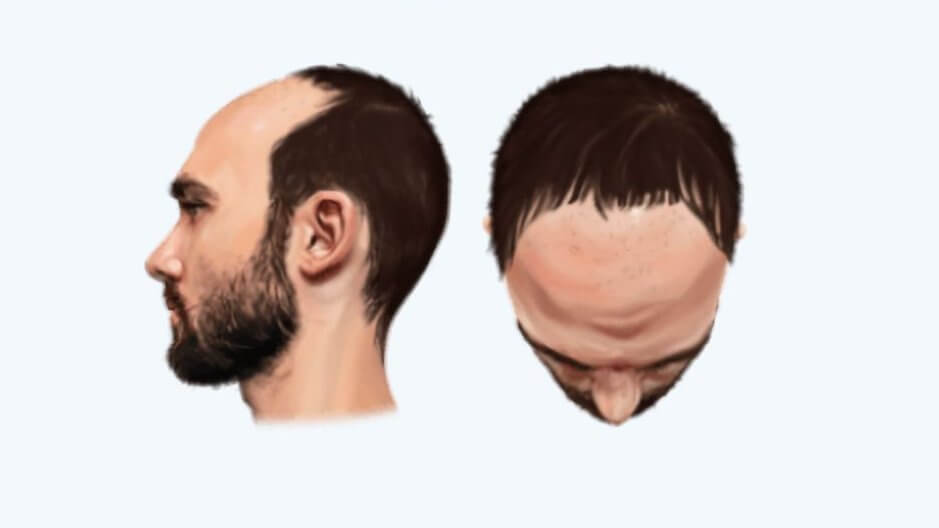
Hair loss progresses even further and reaches the vertex.
Type 5A
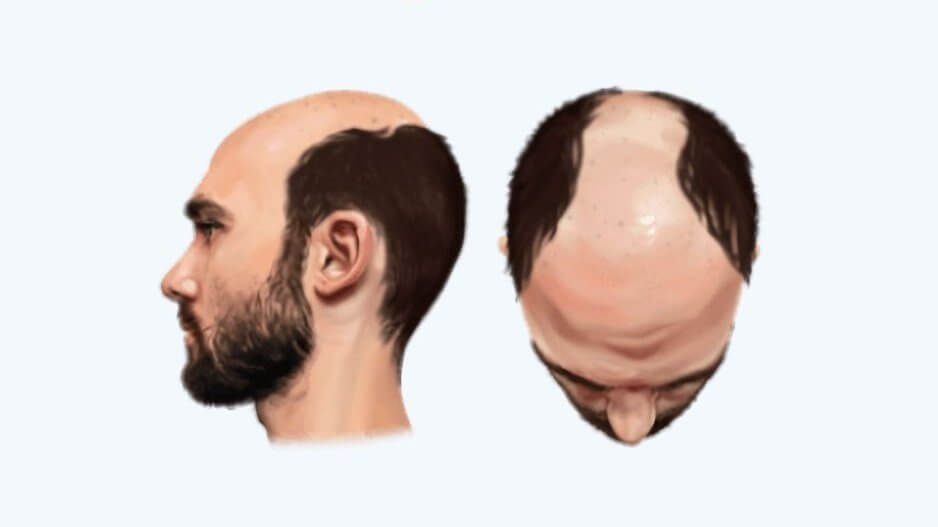
In this stage, the vertex joins in the bald area.
Vertex Baldness Pattern
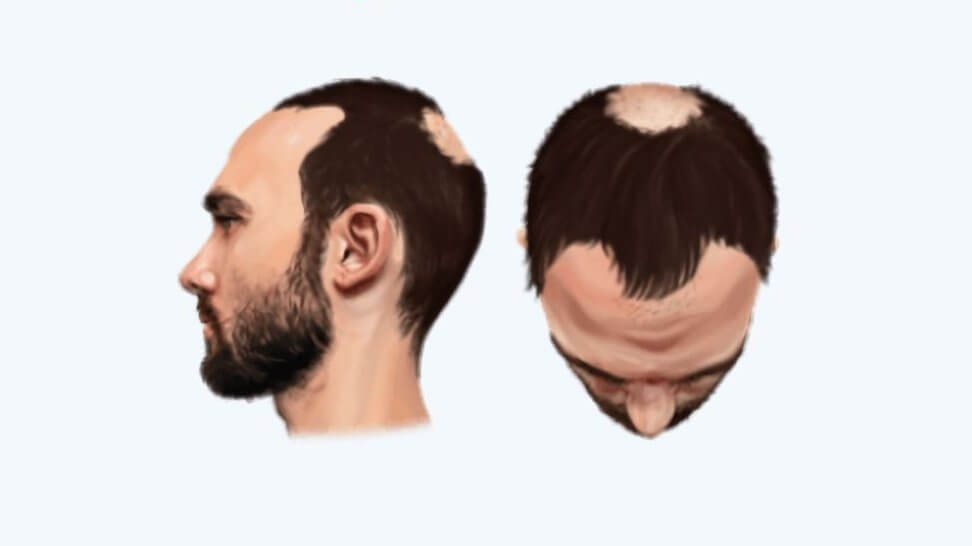
There’s also the vertex variant for the Type 3 stage. This exists because some men with pattern baldness have significant hair loss on the vertex between Type 2 and Type 3.
How will your hair loss pattern evolve according to Hamilton-Norwood Scale?
Mostly, the male pattern hair loss follows 3 paths, starting with H-N Scale Type 1. Then:
- The first hair loss evolution path goes through Types 1, 2, 3, 4, 5, 6, and finally, Hamilton-Norwood Type 7.
- The second path is through Types 1, 2A, 3A, 4A, 5A, 6, and H-N Type 7.
- And the final Hamilton-Norwood scale evolution path is through 1, 2, 3 Vertex, 4, 5, 6, 7.
You can find your current H-N hair loss type on the scale below and see where your next stop would be:
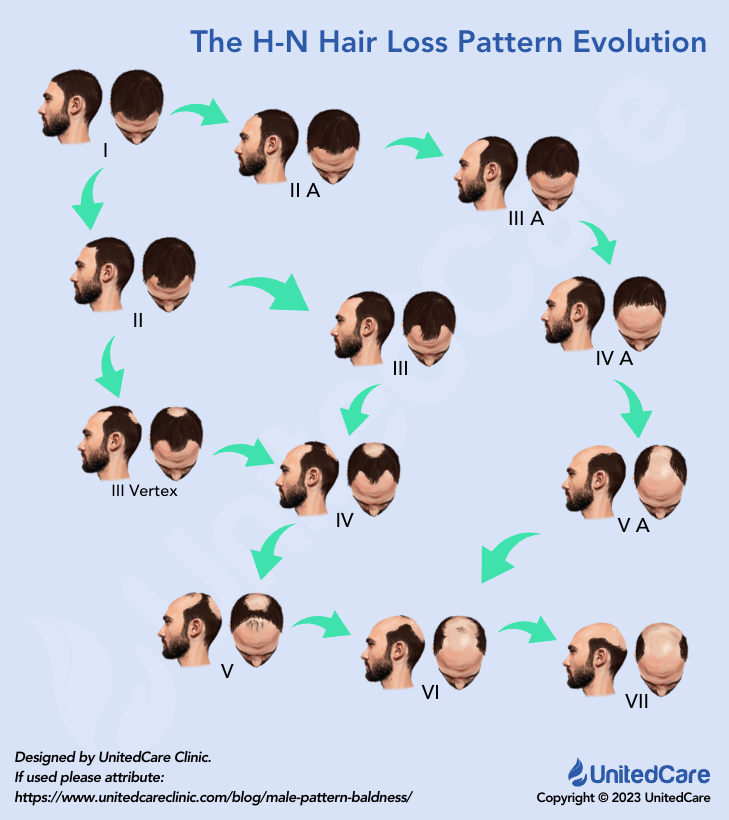
What Causes Male Pattern Balding?
Male Pattern Balding is strongly associated with the male hormones called androgens. These hormones are extremely beneficial in the first stages of your life.
During puberty, androgens help men develop sexually. After that, it has functions such as being part of hair growth and establishing your sex drive in women, too (which is why the same hormone causes female pattern hair loss.)
But, after puberty, if you’re genetically inclined to create certain receptors that interact with androgens, especially DHT, your hair follicles can end up being oversensitive to these hormones, which will result in these hair follicles shrinking, dysfunctioning, even falling out and causing permanent hair loss.
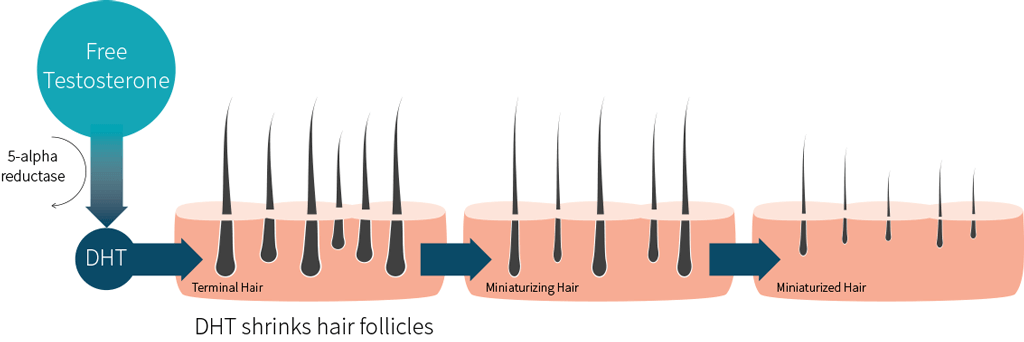
Having no control over whether or not you will experience hair loss is not a comforting fact.
At What Age do Men Start Balding?
Usually, most men lose increasingly more hair at the end of their puberty, around the ages 18-20, due to DHT leaving its function in sexual development and concentrating more on the scalp.
But this hair loss can’t be considered balding yet, since visibly noticing your hair loss this early is impossible. A few strands of hair won’t make a difference for now.
Once you get to your mid-20s, you start to see. Years and years of losing increasingly more hair catch up with your appearance, and you start to notice the changes.
So, between 25-35 are the ages you start balding and have significant changes in your appearance.
Pattern Balding is More Than a Physical Change
Most sources on the internet about male pattern baldness fail to cover the effects of the condition other than the changes in appearance.
The physical changes are just the tip of the iceberg, and androgenetic alopecia can affect every aspect of your life, whether it be your social life, career, or even dating life.
A recent study concluded that “the experience of scalp hair loss in men is psychologically damaging, causing intense emotional suffering, and often leading to personal, social, and work-related problems.”

The last thing we do before we go out and actively participate in our community is men is usually check if our hair is right in the mirror, so the findings of this study make sense.
Not just the study, thousands of hair loss patients I’ve treated over the years from all over the world mentioned the same thing; they’ve lost their self-esteem, thinking they couldn’t go back to their young, natural look. Accepting their life as it is.
But they could, and most did.
Can Male Pattern Baldness be Stopped?
Yes, and no. Yes, because you can stop male pattern baldness from changing your appearance and reduce the effects of it significantly to prevent it from progressing much.
And no, because even if you do everything possible to slow it down, your body will still produce DHT, and the receptors in hair follicles located in certain parts of your scalp will still be damaged and fall out. But, if you take the right approach, neither you nor your close friends and family will notice further balding.
I’ve treated many patients with androgenic alopecia, and I can assure you it is possible to get your natural, young look back.
Here’s our holistic approach here at UnitedCare, to treating androgenic alopecia, a.k.a male pattern baldness:
Step 1 – Remove Anything That Might Aggravate Male Pattern Baldness
Most patients don’t go bald just due to pattern baldness. There are usually various habits or medical conditions they have that trigger AGA.
So, the first step is removing these variables from the equation, to make sure they don’t aggravate their hair loss.
I usually ask a few questions to my patients to determine which of these variables might be or are in play in their condition. But since I don’t know much about your background, here are a few practices that I strongly suggest most of my patients:
✅ Stop Smoking and Excessive Alcohol Consumption
✅ Adopt a Proper Diet That is Healthy and Balanced
✅ Regularly Exercise or Do Yoga to Improve Blood Pressure
✅ Regularly Massage Your Scalp
In my causes of hair loss article, you can find why and how these might promote thinning of hair.
Step 2 – Restore Your Hairline with a Hair Transplant Surgery
Now that you’ve slowed down the progression of your male pattern baldness, it’s time to revert the damage it has done.
Though this might not be necessary for some patients that have seen great benefit from just step 1, most patients need at least a small hair transplant operation to accurately restore their hairline.
First, I examine the balding areas of my patients and then suggest a path forward.
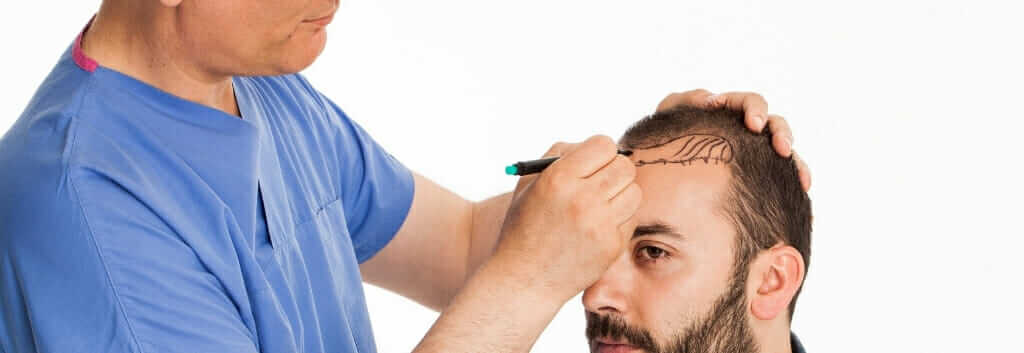
Then, if they go through with the surgery, the procedure starts.
▶ First, right before the surgery, we draw the desired hairline of the patient and plan the surgery before applying local anesthesia to the scalp.
▶ Then, we harvest donor hair from the donor area which is usually the back of the scalp. This area is also called the “safe donor area”, which means the harvested hair follicles are much more resistant to DHT than the hair in the balding parts. So, these harvested hairs stay on top of your scalp forever when implanted.
▶ Once the harvesting is done, I carefully implant each hair follicle on the bald areas of the scalp, making sure we end up with a natural look and a decent hairline.
▶ And when we’re done, we apply a bandage to donor areas and conclude the surgery.
The big majority of these surgeries and their end results are successful, and especially if you adopt the holistic approach we have at UnitedCare, you are even less likely to have any hair transplant failures.
Note that I suggest going with Follicular Unit Extraction (FUE) rather than Follicular Unit Transplantation (FUT) as the hair transplant technique used for natural results.
Step 3 – Make the Necessary Changes in Your Life to Protect Your Hair
The final step is the part where you determine the success rate of the hair transplant surgery and your hair regrowth journey.
Moving forward after the surgery, it’s vital that you provide your body with everything it needs to preserve the planted hair and minimize the further effects of male pattern balding.
If you follow our in-depth post hair transplantation care guide and move forward considering the changes we’ve mentioned in the first step, I can assure you, you won’t have to worry about any form of hair loss anymore.
Taking the First Step – consult a dermatologist
As we’ve said, the first step is getting an accurate diagnosis of your condition.
You can schedule an appointment with your local dermatologist, or you can schedule a free call with me and our expert team:
What if there was a way to restore the hair of your youth?
The hairs at the back of your scalp are resistant to male pattern baldness (AGA) and the transplantation of them might be your permanent solution.
Frequently Asked Questions (FAQs)
Can thinning hair grow back?
Depending on the reason behind the thinning hair and the medical treatment for hair loss available to you, you can grow your thinning hair back. This process can take up to months and exceed years based on your condition.
How do you slow down male pattern baldness?
Male Pattern Baldness usually isn’t the only reason behind hair loss and many of other reasons are easily fixable, so by removing complications and unhealthy habits while adopting proper diet and exercise to improve blood flow to the scalp, you can significantly slow down the progression of male pattern baldness.
Is balding related to testosterone?
Yes, male pattern balding to be specific, is strongly related to male sex hormones, especially dihydrotestosterone, formed from testosterone.
Does M shaped hairline mean balding?
M-shaped hairline is a strong indicator of male pattern baldness, so yes, it might. And though the exact reason behind your hairline can be different, evaluating your scalp and hair health and seeing a dermatologist can help you make sure.
What is a baldness pattern?
Male pattern baldness progresses very similarly in all patients. The Norwood-Hamilton scale helps us visualize this journey.
Can you get bald at 20?
For some men, male pattern baldness can aggressively kick in right after puberty, around the age of 18-20, causing visible and significant balding even before age 20.
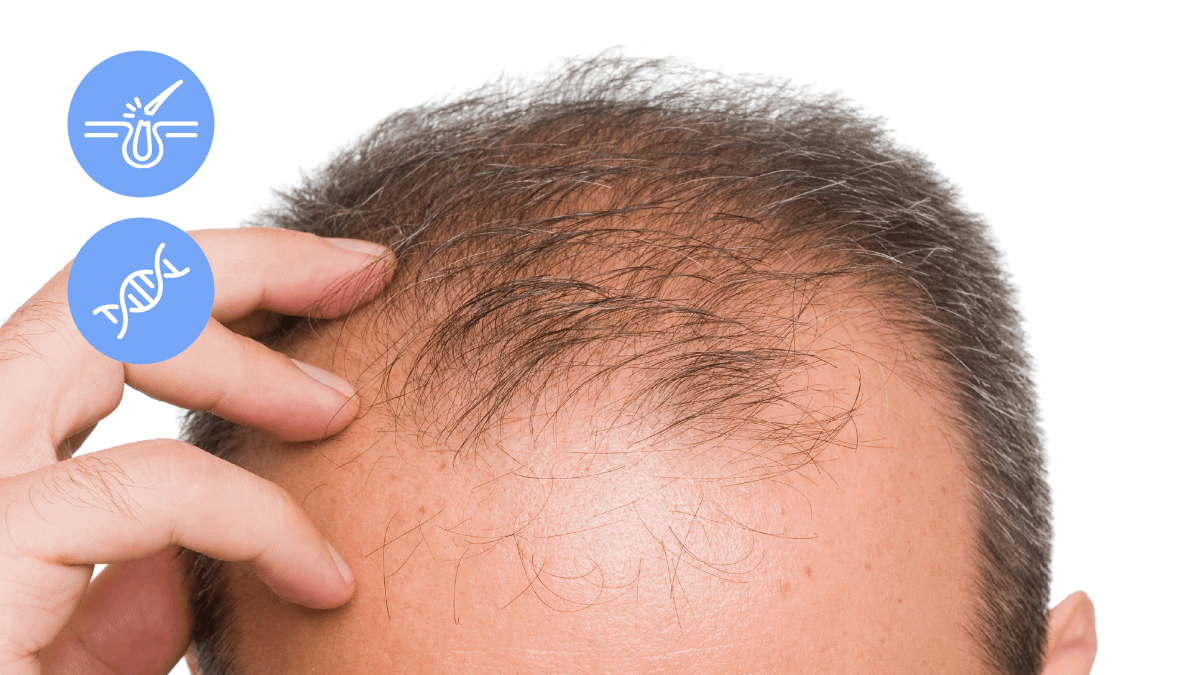

Hi Mr Kisiltac
I may have missed this in your website – could you please provide pictures of a typical client after 1 week 2 weeks 1 month etc.
Thanks David
Hello David,
Please check out the latest additions to the page, especially this part.
Best.